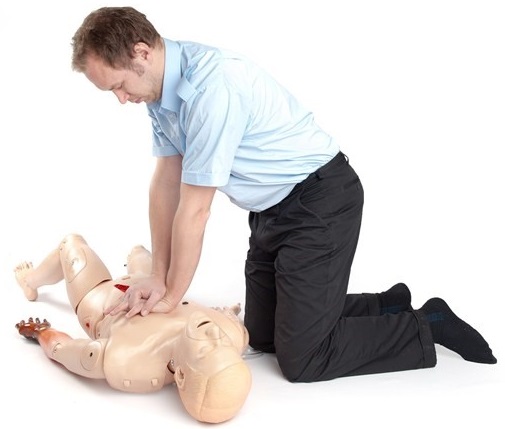Ontario Security Training Certified Security First Aid
First Aid
Emergency First Aid Training Course: 8 Hours
$99.95
Ontario Security Training is the only security training provider to be recognized by the WSIB with a First Aid course specifically designed for security guards.

ROLES AND RESPONSIBILITIES OF THE FIRST AIDER
The first aider
First aid is required to:
Value of first aid training
Legal aspects of first aid
Barriers to action
How is an infection transmitted?
How to prevent disease transmission?
How to minimize mouth-to-mouth contact?
EMERGENCY SCENE MANAGEMENT
Emergency Scene Management
History, Signs and Symptoms, Mechanism of Injury
Call for Emergency Medical Services EMS/911
Unresponsiveness
Fainting
Recovery position
Casualty Management Responsive casualty with suspected head/spinal injuries
Signs and symptoms of head injuries
First aid for head injury including fractures of the facial bones and jaw
Concussion
Compression
Spinal injuries
Position found
Pelvic injuries
Shock
Supine position
Semi-sitting position
Critical Incident Stress (CIS)
ADULT RESUSCITATION
Healthy choices prevent cardiovascular disease
Angina pectoris
Heart attack
Stroke
Cardiac arrest
The chain of survival
Anatomy and Physiology of the heart and lungs
Chest compressions
Location of the heart
Turning a casualty face up with no spinal injury
Turning a casualty face up with spinal injury
Adult CPR
Gastric distension with CPR
Performing CPR on a pregnant woman
AUTOMATED EXTERNAL DEFIBRILLATION
Chase McEachern Act
Life-threatening electrical impulses
Principles of early defibrillation
Structure and function of an AED
AED operation
Using an AED on a child
Special situations
AED maintenance and testing
ADULT CHOKING
Airway obstruction
Prevention and recognize choking
First aid for choking
Severe airway obstruction (conscious adult)
SEVERE BLEEDING AND WOUND CARE
Recognize severe bleeding
First aid for severe bleeding
Dressings and bandages
Internal bleeding
Care of amputated tissue
Types of wounds
Infection of a wound
Wounds with embedded objects
Wound to the palm of the hand
Bleeding from the nose
Bleeding from the gums, tongue and cheek
Bleeding from the scalp and from inside the ear
Abdominal wounds
Insect bites and stings/ Jellyfish stings
Snake bite and animal bites
Leeches
Ticks
Burns
Prevention of burns
Types of burns
Chemical and electrical burns
MEDICAL CONDITIONS
Diabetes
Seizures
Asthma
Allergic reactions that effect breathing
ELECTIVE LESSONS
SECONDARY SURVEY
Secondary survey
History of the casualty
Vital signs
Level of consciousness
Assessing pulse
Secondary survey guide
BONE AND JOINT INJURIES
Prevention
Signs and symptoms of a fracture
First aid for all fractures
Purpose of immobilization
First aid for a lower arm fracture
First aid for an upper arm fracture
First aid for a collar bone fracture
First aid for a lower leg fracture
First aid for an upper leg fracture
First aid for an ankle or foot fracture
First aid for a fractured wrist
Sprains/strains/repetitive strain injury
Dislocation
CHEST INJURIES
Types of chest injuries
Pneumothorax
Tension pneumothorax
Flail chest
Rib fractures
Blast injury
MULTIPLE CASUALTY MANAGEMENT
Multiple casualty management (triage)
Three levels of priority
Triage sequence of actions
RESCUE CARRIES
Principles of safety for moving a casualty
Proper lifting technique
Types of rescue carries
Drag carry
Pick-a-back
Cradle carry
Human crutch
Two-hand seat
Four-hand seat
Chair carry
Blanket lift with four rescuers
EYE INJURIES
Prevention
Particles in the eye
First aid for removing a particle from the eyeball
Remove a particle from the upper and lower eyelid
When you cannot safely remove a particle
Wounds in the soft tissue around the eye
Lacerations and bruises around the eye
Embedded object in or near the eyeball
Extruded eyeball
Chemical burn to the eye(s)
Intense light burns to the eye(s)
POISONS
Prevention
Classifications of poisons
Signs and symptoms of poisoning
First aid for ingested poisons
First aid for inhaled poisons
First aid for absorbed poisons
First aid for injected poisons
HEAT AND COLD INJURIES
Prevention
Frostbite
Hypothermia
Frozen state
First aid for mild and severe hypothermia
Heat cramps
Heat exhaustion
Heat stroke
TWO-RESCUER ADULT CPR
Two-rescuer CPR
How to switch positions
CHILD AND INFANT RESUSCITATION
Causes of breathing emergencies and prevention
Severe airway obstruction (conscious child)
Child CPR
Severe airway obstruction (conscious infant)
Infant CPR